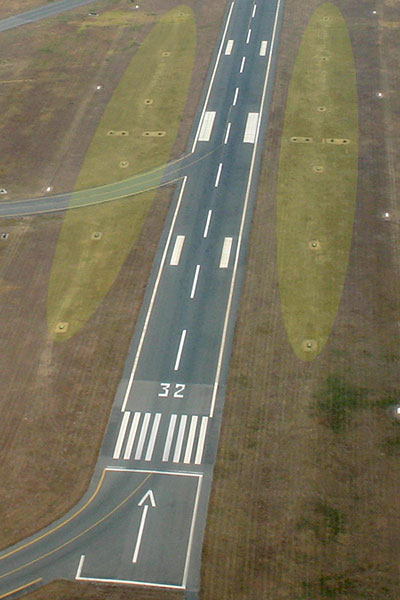
The complete T-VASIS installation takes up considerable real estate, as this photo of Brisbane Airport's Runway 32 in August 2007 shows. The T-VASIS installations have been highlighted on either side of the runway, but note that they are inside the Runway Strip (marked by white gable markers). Each individual light box within the system can be made out - click here to see a close up of a light box. Note that the horizontal part of the T is in line with the start of the runway fixed-distance markings, which define the pilot's aiming point.
The runway markings are also of interest in this shot. Roll your cursor over the photo to identify each marking.
The runway is marked as a Precision Approach Runway, although there is no ILS for either end. Commencing at the bottom of the photo, the arrow indicates a displaced threshold since the runway does not actually start at the beginning of the sealed area (in this case the displacement is 60m).
Then come the threshold markings, designed to let the pilot know they have crossed the start of the runway in bad weather. Above this is the runway designator, in this case 32, indicating the magnetic bearing of the runway to the nearest ten degrees (true bearing 324 degrees).
Solid edge and dashed centreline markings provide definition of the runway itself, whilst the first set of white bars mark the commencement of the touchdown zone. These start 150m from the threshold.
The fixed-distance markings commence 300m from the threshold and the second set of touchdown zone markings, defining the end of the touchdown zone, are 150m beyond the fixed-distance markings.
Note too that runway markings are white, whereas taxiway markings are yellow.
(Photo: Phil Vabre collection)
Click here to read about the history of
T-VASIS
Click here to read the Pilots' Notes on T-VASIS
Back to the main Communications & Navigation index
Back to the main Airports & Aerodromes index
If this page appears without menu bars at top and left, click here